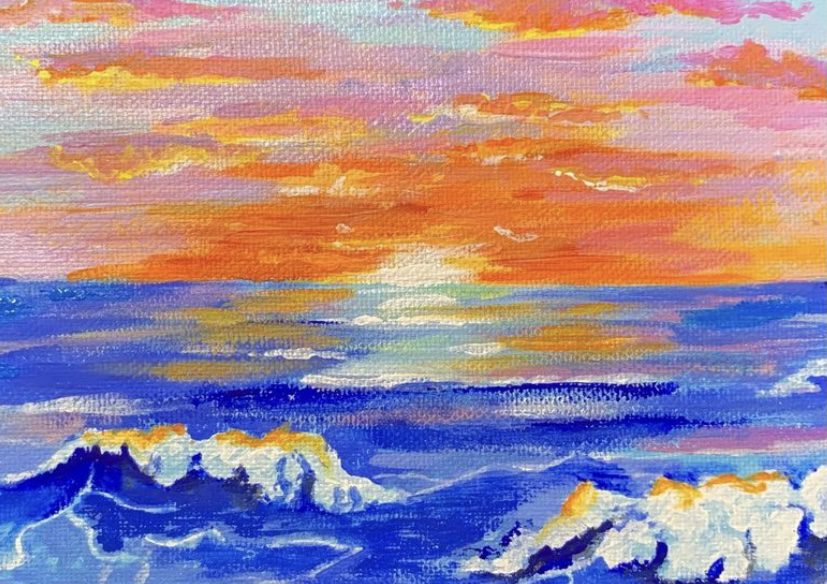I have been using acrylic paint as long as I have been able to hold a paintbrush. Over time, I have developed some techniques that aid the painting process. This article will explain blending acrylic paint and how to make it an asset in your painting skills.
Blending acrylic paint is a technique used to create smooth transitions between different colors or shades of the same color. There are a few tips that will get you started on successful blending:
1.) Choose Your Amount Carefully
As I had mentioned in my generic acrylic paint post, choosing your colors can be tricky. This is besides picking from the color palette and adapting to the colors on your canvas. The amount of paint that you are using, and mixing, matters.
I think the best means for getting a clean blend is to use very small amounts of paint. It will make all the difference in the appearance of the end result.
The reason is because you will then understand the formula to what colors you were mixing really well. Repetitive mixing can help your to better understand the colors components. Then, it makes it easier to know when to add just slightly more or less of one color to begin changing the value or the hue slightly.
2.) Layering
Acrylic paint is not the most opaque paint you can get. Most of the time, the darker the hue (such as brown or blue) the thinner the paint. This means that when you are spreading the paint on the canvas, you can see through the color.
In order to avoid seeing through the color, you can layer. This will lengthen the timespan of your painting because you will have to wait for each layer to dry before adding another.
Layering can also be seen in underpainting techniques such as the Grisaille. If you layer different colors or values on top of each other, it expands the colors into new realms of depth and value.
Because of this, I like to work with thinner layers of acrylic paint. Then, you can allow it to dry very quickly, and add more on top well. This will give you rich colors that flow together well, because they were incorporated through many layers.
One technique you should use when layering is to lay all of your base colors down on the canvas. Then, mix the colors that will make up the “in between” areas that are a combination of the two colors, and blend them into that space.
3.) Using Your Water
When you are using acrylic paint, water is a must! It helps not only to clean your brush for a new color, but it can thin down your paint.
This is great because watered down paint is very easy to mix and blend. If you have two colors laid next to each other on the canvas and wet your brush to then begin blending the middle area, you will have a much easier time than with a dry brush.

4.) Your Work Pace Changes How The Outcome Will Look
There are two main types of acrylic painting that you will want to figure out. Once you know what they are, you can choose which might be better for you. Or, you can use both and evaluate when each of them should be used.
- As I said in tip #2, layering is a great technique for a well blended look. This would fall into the category of a lengthened work pace. You want to let each layer dry before adding a new one.
- The benefits of using a slower pace to your advantage is that each layer can be thinner. The downside, of course, is that it will take you much longer to wait in between each layer.
- Working quickly means blending out your work as fast as possible. If this is done right, it can really have a great affect. It means adding a lot of paint on to the canvas at once and blending it out on there instead of using separate colors at different times.
- The nice thing about how it looks as an end result is that the paint is blending thickly, which means there isn’t a lot of transparency. Basically, you do not have to add more layers!
- The downside could be that mistakes are not easy to correct with more layers over top. Not only this, but the layer that you did put down is very thick, so it takes a lot longer to dry one layer.
5.) Start With The Lighter Color
With oil paints, you always want to work darker to lighter. However, with acrylic paint, you will want to do the opposite. The dark and light colors can overtake each other quite easily.
With oil paint, it is so thick that you need to add a good amount of a color for it to make a difference in the value or the hue. With acrylic paint, only a little amount will affect the paint that you have. Lighter colors are much easier to cover up with acrylic paint.
If you start with the lighter color, you can gradually add more of the darker color or more pigmented color. Gradually adding more depth with more and more of the darker shade is essential for acrylic paints.
FAQs
Should I use acrylic paints for doing a lot of blending in a painting?
Honestly, no. I like acrylic paints because of how textured of a look they give. They give a great chunky, vibrant, and impressionable appeal to a painting. If you are going to be doing a lot of blending, I recommend oil paints because they take so long to dry and are much more buttery.
Why is it hard to blend acrylic paint?
It is hard to blend acrylic paint because it is water based. Basically, it dries to quickly and can be too grainy to blend well. If you think about it in comparison to oil paint, oil bases are much smoother, which is why they are easy to blend.
How do you blend acrylic paint after its dried?
Most of the time, you cannot. I would try using a wet brush to blend the two colors and see if that does anything. If not, then try to mix a color that is close between the two and buff it into the harsh lined area. This should create a pretty good blend!
Comments are closed.


Your article was thought-provoking and well-written. It’s great that you analyzed different perspectives and presented a balanced view of the topic. Your research was thorough, and I gained new insights from reading your article.
Thank you so much! I am glad to hear that you enjoyed my content.